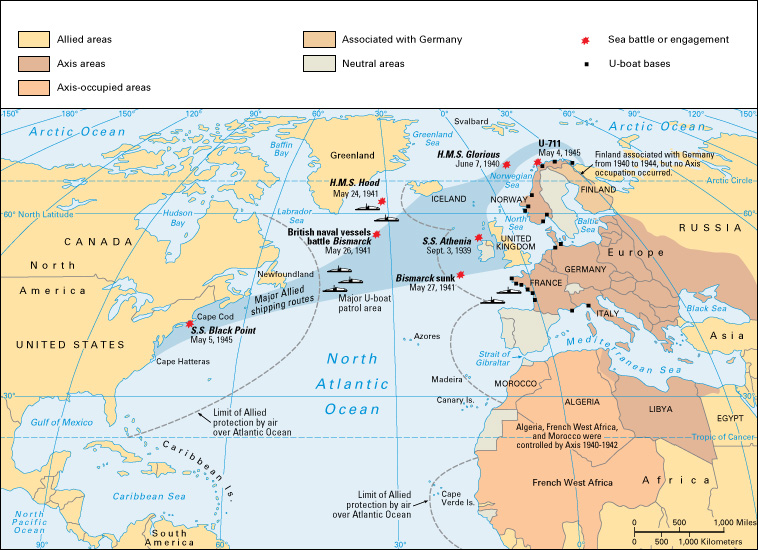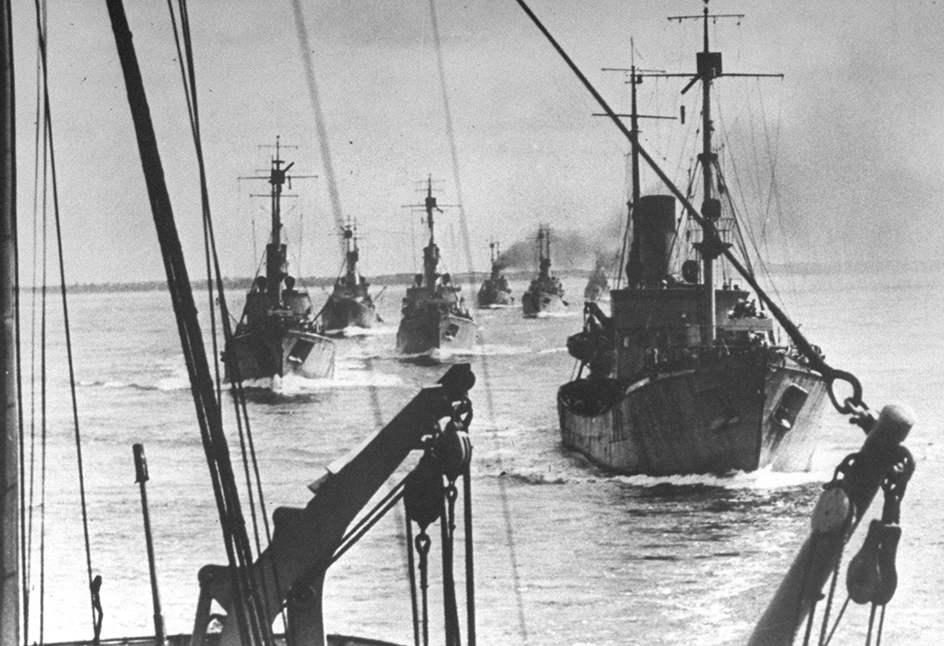Atlantic, Battle of the, was a naval campaign that lasted for the duration of World War II (1939-1945). From the first day of the war to the last, the Allies battled the German Navy, or Kriegsmarine, which tried to stop the transfer of Allied troops and supplies across the Atlantic Ocean. The Allies included the United Kingdom, the United States, Canada, and other nations. The Battle of the Atlantic is most famous for the German submarine campaign against Allied merchant shipping.

When the war started, the German Admiral Karl Dönitz calculated that Germany would need to sink 700,000 tons (635,000 metric tons) of Allied shipping per month to offset new ship construction. The Germans hoped to shut down the United Kingdom’s ability to make war. Toward this end, Germany eventually built and launched more than 1,000 submarines, called Unterseeboote or U-boats. The German Navy reached Dönitz’s monthly goal several times. This was done mainly through the efforts of its U-boat wolf packs (group patrols) operating in the Atlantic. But the Germans underestimated Allied—especially American—shipbuilding capacity. The Allies lost more than 16 million tons (15 million metric tons) of shipping in the Battle of the Atlantic, but they continued building more ships.
Surface clashes dominated the early stages of the Battle of the Atlantic. The German and British navies fought costly, dramatic battles. Newspapers followed the doom of such famous German warships as the Graf Spee and Bismarck, as well as the sinking of the British warships Glorious and Hood. The first victim of Germany’s U-boat campaign was the British passenger liner Athenia, which was torpedoed and sunk on Sept. 3, 1939. By the summer of 1940, the “U-boat peril,” as it was called by British Prime Minister Winston Churchill, had become the greatest threat to Allied shipping and to the supply lifeline of the United Kingdom.
For the next three years, the German U-boat campaign terrorized Allied shipping, sinking thousands of ships while losing relatively few submarines. As in World War I (1914-1918), the Allies adopted a convoy system. In a convoy, transport ships traveled in groups protected by small warships. The Germans countered with their wolf packs, coordinated by radio.

Eventually, new tactics and technology enabled the Allies to get the upper hand. The Allies took advantage of early sonar systems, which used sound energy to locate objects. Allied warships carried depth charges (underwater bombs) to drop over suspected submarine positions. In addition, extensive air patrols tracked down and attacked submarines. The Allies also used direction-finding equipment to locate German radio broadcasts. The Allies broke the Germans’ secret code and monitored their communications (see Codes and ciphers ).
In May 1943 alone, the Allies sank 41 U-boats—about 10 percent of Germany’s entire submarine fleet. From then until the end of the war, the U-boat peril quickly faded. The last U-boat was sunk by aircraft off the coast of Norway on May 7, 1945, just a few hours before Germany’s formal surrender.
The Allies lost more than 70,000 merchant mariners, sailors, and aviators in the Battle of the Atlantic. More than 3,000 Allied ships were lost, compared with nearly 800 U-boats. About 28,000 German submariners were killed—about 2 out of every 3 in the service.
See also Dönitz, Karl ; Submarine (World Wars I and II) ; Torpedo ; World War II (The Battle of the Atlantic) .
